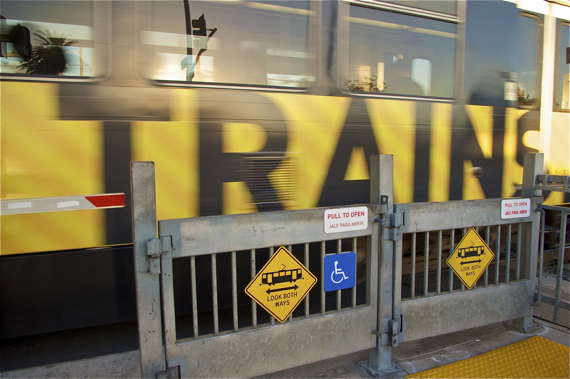On Friday, September 27th, shortly after 6 p.m., 37 year-old Zenon Vazquez opened the gate and stepped in front of the Blue Line train at Vernon.
It's hard to understand how that can happen, given how loud the signal bells are, and the fact that you either have to duck under the pedestrian barrier bar (above left) or open one of the gates. The train passes so close, in fact, that even if you were both deaf and blind, you'd probably still be able to feel it coming.
So, it's not surprising that there are some conflicting accounts of what happened that evening.
Some witnesses say the man was possibly distracted and looking the wrong way. Metro informs me some of their witnesses saw Vazquez and another man walk out of a liquor store toward the station. The companion stopped at the gate, while Vazquez proceeded on through. Whether anyone said anything to try to keep him from doing so is unknown. However, both accounts seem to discourage the notion that the death was a suicide, and one implies intoxication may have been a factor. The coroner says a full report is still pending.
A trip to the Vernon station, however, did offer some clues.
As I stood taking photos of the pedestrian gates, several people walked right through, even as the signals were going off.
It happens all the time, said the older couple that have a vendor stand on the east side of the tracks.
They were still set up on the corner when the incident occurred that Friday, but they hadn't witnessed it.
Although they felt it was very unfortunate, they were only surprised it didn't happen more often.
It had happened shortly after the Metro Safety Ambassador had left for the day, they explained. When no one is around to monitor the area, people are much less likely to obey the signals.
The craziest thing, they said, was that people were jumping between the cars of the stopped train (once the man had been struck), determined to get around it to wherever they had to go. Nevermind that they could have tripped and stumbled into the path of a northbound train.
Both of them shook their heads in dismay.
They have no regard for signals, the older gentleman told me in Spanish, proving his point by pointing at a family with young kids crossing the intersection against the light.
It doesn't make sense, he said. There are more than enough safety devices; people just need to start paying attention to them.
Speaking of safety devices, in my last look at safety along the Blue Line, I discussed Metro's agreement with Union Pacific that would allow Metro to install additional gates and signage along the UP side of the crossings. UP had balked at the idea until recently, afraid that being asked to upgrade safety measures in one city would mean they would be asked to do the same along the thousands of miles of track they own across the country.

Metro had hoped to have those plans for upgrades ready for bid this past July. As of now, it appears that plans for improvements, including pedestrian gates and swing gates at 27 intersections, won't be out to bid until next spring. Meaning, construction won't start until next summer at the earliest and should be completed by February 2016.
And while that is heartening (if slow-paced), none of the improvements would have done much to help in Vazquez' case.
While there is no question that Vernon intersection itself is a highly uncomfortable crossing for pedestrians or cyclists, Vazquez stepped into the train's path at the one corner where there are gates, barriers, and very loud signals.
His is the fifth death along the Blue Line this year, three of which have been determined to be suicides.







